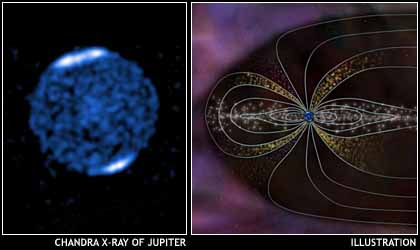Avi Blizovsky

Direct link to this page: https://www.hayadan.org.il/aurorajupiter170305.html
Scientists have recently gained new insight into the unique force behind many of Jupiter's auroras, the most spectacular phenomena in the Solar System. Extended monitoring of the giant planet using the Chandra X Observatory has revealed the presence of ionized particles crashing into the atmosphere above the poles.
The X-ray spectrum measured by Chandra showed that the aurora activity was created by oxygen ions and other elements stripped of most of their electrons. This means that these particles are accelerated to high energies and create an environment of millions of volts above the planet's poles. The presence of these energetic ions indicates that the cause of most of the differences between the auroras of Jupiter and those of Earth or Saturn.
No spacecraft has explored the regions above Jupiter's poles, so X-ray observatories are one of the few ways to study this environment, said Ron Elsner of NASA's Marshall Space Center in Huntsville, Alabama, and lead researcher on a recent study describing these results in the journal Geophysical Research. . "These results will help scientists understand the mechanism that causes the strong power of Jupiter's auroras, which are thousands of times stronger than the most powerful aurora events on Earth.
An electrical voltage of 10 million volts and currents of 10 million amperes - hundreds of times stronger than the strongest lightning on Earth are needed to explain the observations in the X field. Such voltages may also explain the radio emissions from energetic electrons observed near Jupiter by the Ulysses spacecraft.
On Earth, aurora borealis events are caused by solar storms of energetic particles, which cause disturbances to the Earth's magnetic field. Flows of particles from the Sun can also produce auroras on Jupiter, but unlike on Earth, Jupiter has another way of producing auroras. The rapid rotation of Jupiter, a huge magnetic field, and an unlimited flow of particles from the active volcanic moon Io, creates a huge pool of electrons and ions. The charged particles caught in Jupiter's magnetic field are constantly accelerated down into the atmosphere above the polar regions, where they collide with the gases and create the aurora, which is almost always active on Jupiter.
If the particles responsible for the aurora borealis came from the Sun, they would have to be accompanied by a large number of protons, which would have produced a strong glow in the infrared range. Ultraviolet observations made by Hubble during Chandra's Jupiter monitoring period revealed only a faint ultraviolet flare.
The combined Chandra and Hubble data suggest that auroral activity was caused by the acceleration of charged ions of oxygen and other elements trapped in the polar magnetic field high above Jupiter's atmosphere.
Chandra observed Jupiter in February 2003 during its four orbits (about 40 hours) during strong aurora activity. These Chandra observations were made using the sophisticated CCD imaging spectrometer, and were accompanied by an hour and a half of observations in the Hubble's ultraviolet range.
Chandra site
For information on the Chandra website
For information on the site
https://www.hayadan.org.il/BuildaGate4/general2/data_card.php?Cat=~~~109109761~~~19&SiteName=hayadan
